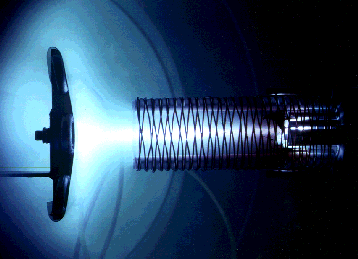
Cathodic-arcs can produce plumes of highly charged ions from any conducting material. We are investigating the basic physics of cathodic-arcs, and pursuing three particular applications: (1) deposition of diamond-like-carbon (DLC) films, (2) direct metal-ion Plasma Source Ion Implantation (PSII), and (3) implantation/deposition of adherent ceramic metal-oxide, -nitride, and -carbide films.
Using our high-voltage PSII modulator (20 us, 60 A, 50 kV pulses at 2 kHz) to implant a metal-ion plasma greatly increases the adherence of subsequently deposited metal or metal-oxide ceramic films. We have found that we can deposit adherent, stochiometric erbium oxide (erbia) of several microns thickness on a variety of substrates.

In related research, we are working to deposit highly adherent coatings of
refractory metal on the inside surfaces of pipes. The principal challenge
here is figuring out a way to create or transport the metal-ion plasma
inside the pipe, and then to pulse bias the pipe so as to achieve ion
implantation. In other words, it is a problem of establishing an appropriate
ground reference, since in a long pipe, the plasma might be expected to
simply float up to the applied bias. Our colleagues in MST-4 (Nastasi and
Walter) are pursuing the same goal using a plasma created out of a organo-metallic
gas, rather than our cathodic-arc based approach.
This page last updated by Blake P. Wood, on 10/13/99. bwood@lanl.gov
Return to the Applied Plasma Technologies homepage
The Plasma Physics Group (P-24) homepage
The Materials Science and Technology Division (MST) homepage